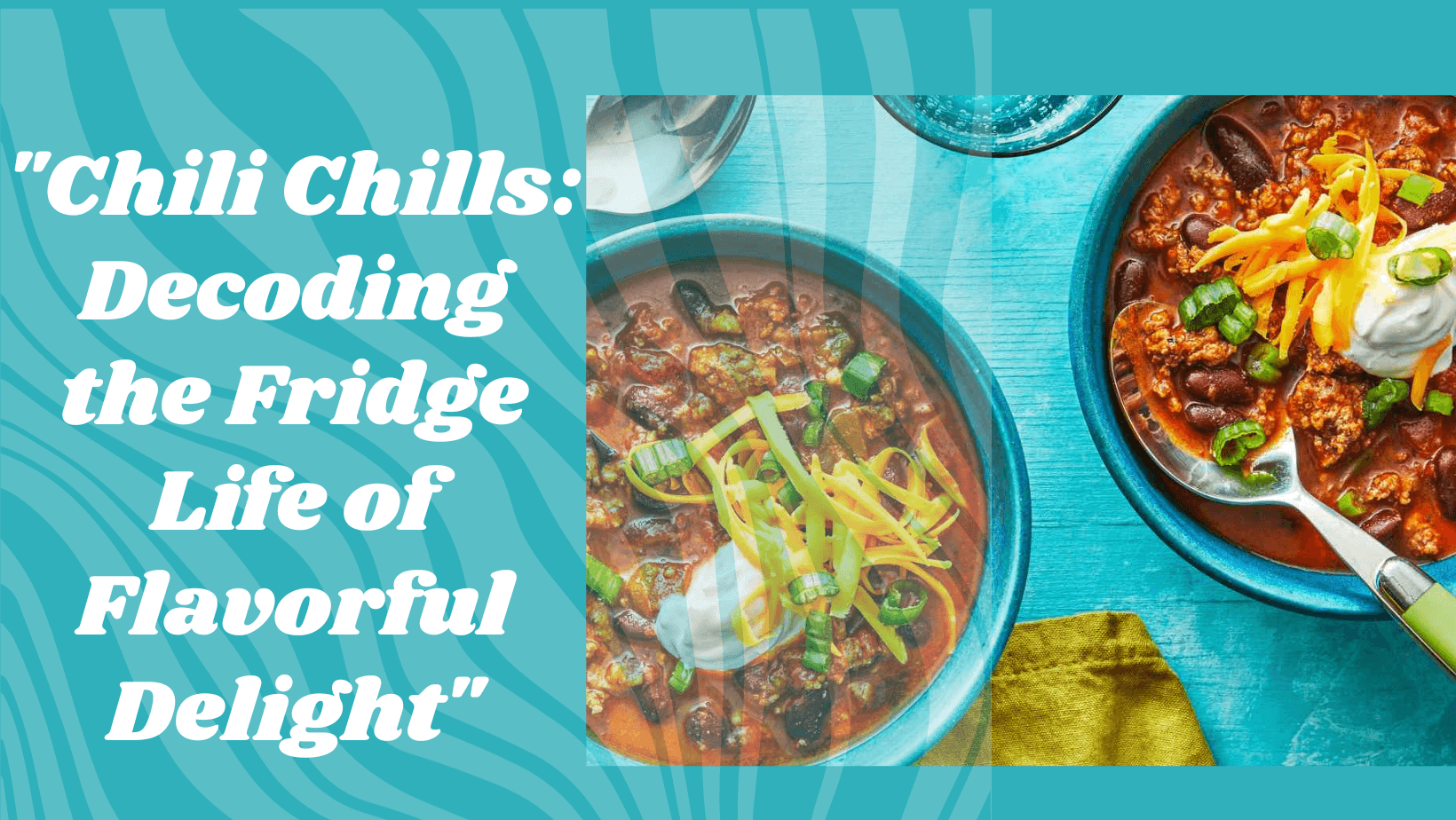Don’t let your mouth water only to be disappointed by spoiled chili!
We all crave that delicious savory comfort, but how long can chili really stay fresh in the fridge?
Find out the key to preserving its flavors and avoiding any unpleasant surprises after the jump.
how long is chili good in the fridge
Chili can last for three to four days when stored properly in the refrigerator.
It is important to store chili within two hours after cooking or purchasing it from a restaurant.
Proper storage includes transferring chili into an airtight container, storing it in the coldest part of the fridge, and labeling and dating it.
Chili should be checked for signs of spoilage before reheating and eating, and it should be reheated to an internal temperature of 165°F before serving.
After four days, it is recommended to discard any remaining chili.
Key Points:
- Chili can last for three to four days in the fridge
- Store chili within two hours of cooking or purchasing
- Transfer chili into an airtight container and store in the coldest part of the fridge
- Label and date the chili for proper storage
- Check for signs of spoilage before reheating and eating
- Reheat chili to an internal temperature of 165°F before serving
how long is chili good in the fridge – Watch Video
💡
Pro Tips:
1. The first recorded evidence of chili dates back to the ancient Aztecs, who used a combination of chili peppers, meat, and herbs to prepare their version of this delicious dish.
2. Contrary to popular belief, chili can actually last in the fridge for up to five to seven days if stored properly in an airtight container. However, it is always advisable to consume it within three to four days for optimal taste and freshness.
3. Did you know that chili peppers contain a compound called capsaicin, which is responsible for the spicy sensation? Capsaicin has been found to have various health benefits, including pain relief, appetite suppression, and even boosting metabolism.
4. Over time, different regions have developed their own unique styles of chili. For instance, Texan chili typically contains no beans, while Cincinnati chili incorporates aromatic spices like cinnamon and chocolate. This regional diversity adds to the charm and versatility of this beloved dish.
5. Chili was not always associated with being spicy. The term “chili” actually derives from the Nahuatl word “chīlli,” which referred to any type of pepper, regardless of its heat level. Traditional chili recipes included mild peppers like bell peppers, aiming to enhance the flavor rather than the spiciness.
Proper Storage Of Chili In The Fridge
Proper storage of chili in the fridge is crucial to ensure its longevity and to avoid any risks of foodborne illnesses. Chili can last for three to four days when stored correctly in the refrigerator. It is essential to store chili within two hours after cooking or purchasing it from a restaurant. This two-hour window is crucial as it prevents the growth of harmful bacteria, which can occur when food is left at room temperature for an extended period.
Additionally, storing chili in an airtight container is essential to prevent air and moisture from entering, which can accelerate the spoilage process. The container should be placed in the coldest part of the fridge, usually at the back near the bottom shelf. This area provides a stable and colder temperature that helps maintain the quality of the chili.
Importance Of Storing Chili Within Two Hours
Storing chili within two hours after cooking or purchasing is of utmost importance. When cooked food is left at room temperature for more than two hours, harmful bacteria can multiply rapidly, increasing the risk of foodborne illnesses. These bacteria thrive in the temperature danger zone, which is between 40°F and 140°F.
To ensure the safety of the chili, it should be promptly transferred to the refrigerator within the two-hour window. This applies not only to freshly cooked chili but also to chili purchased from a restaurant or deli. If you are unsure of the time the chili was cooked or purchased, it is best to err on the side of caution and discard it. Remember, the consequences of consuming food that has exceeded the safe time limit are not worth the risk.
- Promptly transfer cooked or purchased chili to the refrigerator within two hours.
- Discard chili if unsure of the cooking or purchase time.
- Consequences of consuming chili beyond the safe time limit are not worth the risk.
“Storing chili within two hours after cooking or purchasing is of utmost importance. When cooked food is left at room temperature for more than two hours, harmful bacteria can multiply rapidly, increasing the risk of foodborne illnesses. These bacteria thrive in the temperature danger zone, which is between 40°F and 140°F.”
Steps For Proper Storage Of Chili
Proper storage of chili requires a few simple steps to ensure its freshness and prevent the growth of harmful bacteria. After cooking or purchasing chili, follow these steps:
-
Transfer the chili into an airtight container: Using an airtight container is essential to prevent air and moisture from entering and spoiling the chili. It also helps to retain its flavor and prevent any odors from permeating the refrigerator.
-
Store in the coldest part of the fridge: Place the container of chili in the coldest part of the fridge, usually at the back near the bottom shelf. This area provides a consistent and colder temperature, which helps maintain the quality and freshness of the chili.
-
Label and date the container: It is crucial to label and date the container of chili. This allows you to keep track of its freshness and ensure that you consume it within the recommended time frame. Use a permanent marker or label maker to clearly mark the date of storage.
By following these steps, you can maximize the shelf life of your chili and enjoy it safely without any concerns about spoilage or foodborne illnesses.
Checking For Spoilage Before Reheating
Before reheating and eating leftover chili, it is essential to check for signs of spoilage. The appearance, smell, and texture of the chili can indicate whether it is still good to consume or if it has gone bad.
Signs of spoilage in chili include mold growth, change in color, sour smell, or an off smell. If you notice any of these signs, it is best to discard the chili. Consuming spoiled chili can lead to food poisoning, with symptoms such as nausea, vomiting, abdominal cramps, and diarrhea.
If the chili appears normal and does not exhibit any signs of spoilage, it is generally safe to reheat and consume. However, remember to follow the proper reheating guidelines to ensure the elimination of any potential bacteria.
Discarding Remaining Chili After Four Days
The maximum recommended time for keeping chili in the refrigerator is four days. After this time, it is recommended to discard any remaining chili, even if it appears and smells fine.
Over time, the quality of chili deteriorates, and harmful bacteria may have multiplied, increasing the risk of foodborne illnesses. To avoid any health risks, it is best to err on the side of caution and discard the chili after four days.
By adhering to this guideline, you can ensure the safety of your meals and enjoy fresh and delicious chili without any concerns about foodborne illnesses.
Factors Affecting The Longevity Of Chili In The Fridge
Several factors can affect how long chili can last in the fridge. The longevity of chili depends on how it was cooked, how it is stored, and the age of the ingredients used.
When chili is cooked at a high temperature, it helps kill off harmful bacteria, increasing its shelf life. Additionally, using fresh ingredients is crucial as old or expired ingredients may contain bacteria that can spoil the chili faster.
Proper storage practices, such as transferring chili into an airtight container and storing it in the coldest part of the fridge, can significantly extend its shelf life. These practices help maintain the quality and freshness of the chili by minimizing exposure to air and moisture.
It is essential to note that these factors are interrelated, and neglecting any one of them can reduce the longevity of the chili. By ensuring that all factors are taken into consideration, you can maximize the shelf life of your chili and safely enjoy it for a longer period.
Discarding Chili Not Brought To A Boil Within Two Days
If chili is not brought to a boil within two days of being stored in the refrigerator, it is recommended to discard it. When freshly cooked chili is not heated to a sufficiently high temperature, harmful bacteria may have developed during the cooling process.
To ensure the safety of your chili, it is crucial to reheat it to at least 165°F before consuming. This temperature is known to kill off most harmful bacteria and prevent the risk of foodborne illnesses.
If you are unsure whether the chili has reached the recommended temperature during the initial cooking or reheating process, it is best to discard it to avoid any potential health risks.
- Discard chili if not brought to a boil within two days in the refrigerator.
- Reheat chili to at least 165°F to kill harmful bacteria.
- If unsure, discard chili to avoid potential health risks.
Discarding Expired Ingredients Used In Chili
Using expired ingredients in chili can pose a significant risk to your health. Expired ingredients may contain harmful bacteria that can spoil the chili faster and increase the risk of foodborne illnesses.
Before using any ingredients for chili, it is essential to check their expiration dates. Discard any ingredients that have expired or show signs of spoilage, such as mold or an off smell.
To ensure the freshness and safety of your chili, always use fresh and unexpired ingredients. This will help maintain the quality and reduce the risk of foodborne illnesses.
- Check the expiration dates of ingredients
- Discard expired or spoiled ingredients
- Use fresh and unexpired ingredients to maintain quality and reduce the risk of foodborne illnesses.
Common Causes Of Spoiled Chili
Spoiled chili can result from several factors, such as improper storage, cooking at a high temperature, or using expired ingredients. These factors create an environment for the growth of harmful bacteria, which leads to spoilage.
Improper storage practices, such as leaving chili at room temperature for an extended period or not sealing it in an airtight container, can accelerate the spoilage process.
Cooking chili at a high temperature, typically bringing it to a boil, is crucial to eliminate or reduce the population of harmful bacteria that may be present in raw ingredients.
Using expired or spoiled ingredients in chili can introduce harmful bacteria that can spoil the entire dish.
To prevent the common causes of spoiled chili, it is important to adhere to proper storage practices, use fresh ingredients, and cook at the appropriate temperatures.
Risks Of Eating Expired Chili
Consuming expired chili can lead to food poisoning and various health risks. Expired chili may contain harmful bacteria that can cause foodborne illnesses such as salmonella, E. coli, or listeria.
Symptoms of food poisoning can range from mild to severe and include nausea, vomiting, abdominal cramps, and diarrhea. In severe cases, food poisoning can lead to dehydration and more serious complications.
To avoid these risks, it is crucial to:
- Store and consume chili within the recommended timeframes
- Check for signs of spoilage before reheating and eating.
By being mindful of the freshness and quality of the chili, you can enjoy a safe and delicious meal without any health concerns.
In conclusion, proper storage of chili in the fridge is essential to ensure its longevity and safety.
Chili can last for three to four days when stored correctly in the refrigerator. To maximize freshness, follow these steps:
- Store chili within two hours after cooking or purchasing to prevent the growth of harmful bacteria.
- Transfer chili into an airtight container, store it in the coldest part of the fridge, and label and date it.
- Check for signs of spoilage before reheating. Discard any chili that shows mold, strange odors, or odd colors.
- Any remaining chili should be discarded after four days.
Factors such as cooking method, storage practices, and ingredient freshness affect the longevity of chili. Discarding chili not brought to a boil within two days and expired ingredients used in chili is recommended. Proper storage and cooking practices can prevent common causes of spoiled chili.
Eating expired chili can lead to food poisoning, so it is important to be aware of the risks. By following these best practices, you can enjoy fresh and safe chili that is both flavorful and nutritious.
💡
You may need to know these questions about how long is chili good in the fridge
Can you eat leftover chili after 7 days?
While the general guideline for consuming cooked leftovers is 3 to 4 days, it is recommended to exercise caution when it comes to chili. Due to its high moisture content and potential for bacterial growth, it is generally advised not to consume leftover chili after 7 days. Proper refrigeration can slow down the growth of bacteria, but it is important to prioritize safety when it comes to perishable foods. Therefore, it is advisable to err on the side of caution and discard any leftover chili that has been stored for more than 7 days.
Is chili still good after 6 days?
Chili generally remains good for up to six days when stored properly in the refrigerator. However, after the recommended 3 to 4-day mark, the quality and taste might begin to deteriorate. While it may still be safe to consume, the flavors can become less vibrant, and the texture may change slightly. To ensure the best culinary experience, it is ideal to consume chili within the suggested timeframe.
Is 5 day old chili safe to eat reddit?
It is generally not recommended to eat chili that is 5 days old, as it may pose a risk of foodborne illnesses. While cooked chili can be stored in the refrigerator for up to a week, it is best to consume it within 3 to 4 days for optimal safety and taste. Proper storage in covered airtight containers can help extend its shelf life, but it is always advised to exercise caution when consuming leftovers beyond the recommended timeframe.
Is chili good after 5 days?
Yes, chili without meat or dairy, as well as canned chili, can typically remain good in the refrigerator for about a week. However, it is advisable to consume chili with meat or dairy within 3-4 days if stored in the fridge. Additionally, freezing chili extends its shelf life significantly, allowing it to stay good for up to 6 months, regardless of the ingredients. Therefore, it is important to consider the ingredients when determining how long chili can remain safe for consumption.
Reference source
https://mollysmtview.com/recipes/how-long-does-chili-last-in-the-fridge
https://www.quora.com/How-long-does-leftover-chili-last-in-the-fridge
https://www.stilltasty.com/fooditems/index/16809
https://pipandebby.com/pip-ebby/how-long-does-chili-last-in-the-fridge/



